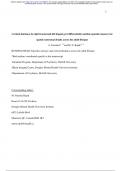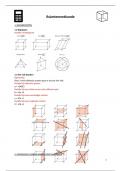bioRxiv preprint doi: https://doi.org/10.1101/289447. this version posted March 27, 2018. The copyright holder for this preprint (which was not
certified by peer review) is the author/funder. All rights reserved. No reuse allowed without permission.
1
Cortical thickness in right frontal and left lingual gyri differentially mediate episodic memory for
spatial contextual details across the adult lifespan
A. Swierkot* 1, 2and M. N. Rajah*2,3
RUNNING HEAD: Episodic memory and cortical thickness across the adult lifespan
*Both authors contributed equally to this manuscript
1Graduate Program, Department of Psychiatry, McGill University
2Brain Imaging Centre, Douglas Mental Health University Institute
3Department of Psychiatry, McGill University
Corresponding author:
M. Natasha Rajah
Room 2114 CIC Pavilion
Douglas Mental Health University Institute
6875 LaSalle Blvd
Montreal, QC, Canada H4H 1R3
maria.rajah@mcgill.ca
,bioRxiv preprint doi: https://doi.org/10.1101/289447. this version posted March 27, 2018. The copyright holder for this preprint (which was not
certified by peer review) is the author/funder. All rights reserved. No reuse allowed without permission.
Changes in context memory and cortical thickness across the adult lifespan 2
Abstract
Healthy aging is associated with declines in episodic memory and with widespread cortical thinning.
These parallel declines suggest that age-related changes in cortical thickness may contribute to episodic
memory decline with age. The current study uses a cross-sectional study design to examine whether
regional cortical thickness mediates the relationship between age and episodic memory, as measured by
a context memory task for faces. Mediation and conditional mediation models were tested using
bootstrapping in order to determine how age-associated changes in regional cortical thickness mediated
age-associated changes in performance on the context memory task. We observed that right superior
frontal cortical thickness conditionally mediated spatial context memory only in middle-aged and older
adults; and right caudal middle frontal cortical thickness conditionally mediated context memory only
in older adults. Left lingual cortical thickness mediated spatial context memory across the adult
lifespan, but this effect was most evident at midlife. Right parahippocampal cortical thickness mediated
context memory, independent of age. We conclude that our cortical thickness results were generally
consistent with the posterior-to-anterior shift in aging hypothesis (Davis et al., 2008) for episodic
memory.
,bioRxiv preprint doi: https://doi.org/10.1101/289447. this version posted March 27, 2018. The copyright holder for this preprint (which was not
certified by peer review) is the author/funder. All rights reserved. No reuse allowed without permission.
Changes in context memory and cortical thickness across the adult lifespan 3
1. Introduction
Healthy aging is associated with declines in the ability to remember an item or event in rich
contextual detail (episodic memory; Tulving, 1984). Studies have shown that episodic memory tasks
that assess one’s ability to encode and retrieve contextual details (item-context associative memory
tasks) are more sensitive at detecting age-associated episodic memory deficits, compared to item
recognition tasks (Cansino, 2009; Dulas & Duarte, 2012; Glisky, Polster, & Routhieaux, 1995;
Mattson, Wang, de Chastelaine, & Rugg, 2013; Rajah, Languay, & Valiquette, 2010; Schacter,
Kaszniak, Kihlstrom, & Valdiserri, 1991; Trott, Friedman, Ritter, & Fabiani, 1997). FMRI studies of
young adults have shown increased activity in medial temporal lobes (MTL) and prefrontal cortices
(PFC) during associative context memory tasks, compared to item recognition tasks (Davachi, 2006;
Maillet & Rajah, 2013; Shing et al., 2010; Staresina & Davachi, 2008). Moreover, it has been
hypothesized that successful encoding and retrieval of item-context associations in young adults relies
on the engagement of a distributed network of brain regions including sensory cortices, MTL, inferior
parietal cortex (IPC) and PFC (H. Kim, Daselaar, & Cabeza, 2010; Nyberg et al., 2000; Rugg &
Vilberg, 2013). Thus, it follows that age-related decrements in item-context associative memory tasks
may be mediated by structural changes in any (or all) of the brain regions implicated with successful
memory encoding and retrieval in young adults (Braskie, Small, & Bookheimer, 2009; Spencer & Raz,
1994).
Several studies have reported age-related volumetric decline in brain regions related to encoding
and/or retrieval of contextual details from episodic memory (Fjell et al., 2013; Hogstrom, Westlye,
Walhovd, & Fjell, 2013; Raz, Ghisletta, Rodrigue, Kennedy, & Lindenberger, 2010; Walhovd et al.,
2011). Salat et al (2004) reported reductions in cortical thickness with age in PFC, supramarginal
gyrus, and calcarine sulcus, with relative preservation of lateral temporal cortex thickness. Raz et al
, bioRxiv preprint doi: https://doi.org/10.1101/289447. this version posted March 27, 2018. The copyright holder for this preprint (which was not
certified by peer review) is the author/funder. All rights reserved. No reuse allowed without permission.
Changes in context memory and cortical thickness across the adult lifespan 4
(2005) also reported a steady decline in PFC grey matter volumes with age, starting in young
adulthood. However, five year longitudinal follow-up data indicated there was notable individual
variability in how PFC volumes changed with age, with some subjects exhibiting volumetric decline,
and other subjects exhibiting either no change or increased PFC volume at five year follow-up (Raz et
al., 2005). In contrast to a general decrease in PFC volumes throughout adulthood, hippocampal
volume decline with age exhibits a non-linear pattern. For example, Walhovd et al (2011) have
reported changes in hippocampal volumes with age resembling an inverted-U shape, which was
suggestive of accelerated volume loss in this region in late midlife onwards. This observation was
corroborated by Fjell et al (2013). Therefore, there is significant evidence that aging is related to
structural decline in several brain regions associated with episodic memory.
However, fewer studies have examined whether age-related declines in brain volume and/or
cortical thickness directly relates to age-related decline in episodic memory tasks. In other words, do
age-related differences in regional cortical thickness or brain volume mediate the effect of age on
memory function? In one study, Walhovd et al. (2006) used a cross-sectional study design to examine
the relationship between cortical thickness and episodic memory, as measured by long-term recall on
the California Verbal Learning Task (CVLT), in a full lifespan sample. Through a whole-brain vertex-
wise analysis they found that after controlling for age, long-term recall was positively associated with
cortical thickness in bilateral gyrus rectus, bilateral medial frontal gyrus, bilateral parieto-occipital
sulcus, bilateral lingual gyri, right temporal and parietal lobes, and left precuneus throughout the adult
lifespan (Walhovd et al., 2006). Importantly, this analysis uncovered these brain-behaviour
relationships after controlling for age, meaning that this analysis explained how individual differences
in cortical thickness related to memory. However, it did not assess whether cortical thickness mediated
the effect of age on memory performance. Head, Rodrigue, Kennedy, & Raz (2008) aimed to answer
this question by conducting a path analysis to test the hypothesis that age-associated changes in





